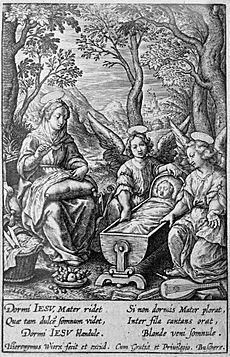The Virgin's Cradle Hymn facts for kids
The Virgin's Cradle Hymn is a short and sweet lullaby poem. It was found by an English poet named Samuel Taylor Coleridge when he was traveling in Germany. He published it in his book Sibylline Leaves in 1817. Coleridge wrote that he copied the original Latin words from a picture of the Virgin Mary in a Catholic village. This poem, which came from a collection of old drawings by Hieronymus Wierix, has inspired many modern songs for choirs and singers.
How the Poem Was Found
In 1798, Coleridge went on a trip to Germany with his good friend William Wordsworth. This was soon after they published their book Lyrical Ballads. In May 1799, about a year into his trip, Coleridge saw the picture in a village inn. His diary says it was in a Catholic village near Mainz.
The picture was an old Dutch drawing. It came from a book called Jesu Christi Dei Domini Salvatoris nostra Infantia. This book was a collection of drawings and poems by a Flemish artist named Hieronymus Wierix (who lived from 1553 to 1619). The poem went with a picture called "The Virgin Sewing While Angels Rock Her Son to Sleep." This drawing showed baby Jesus sleeping in a cradle. Two angels were rocking him, while the Virgin Mary sat nearby, doing needlework.
Coleridge sent the Latin poem to a newspaper called the Courier in 1801. He called himself "A Correspondent in Germany." Even though he had translated it in his notebook, Coleridge waited almost ten years to publish his English version. He first published both the Latin and English versions together in the Courier in 1811. Coleridge later shared the story of how he found the poem. He also suggested that it could be sung to the tune of "O Come, All Ye Faithful". He then put the poem and his translation in his own book, Sibylline Leaves, in 1817.
The Poem's Words
The poem is a gentle lullaby, sung by the Virgin Mary to baby Jesus.
|
Dormi, Jesu! Mater ridet |
Sleep, sweet babe! my cares beguiling: |
| —Latin original | —Translation by S. T. Coleridge |
Holy Infant in Thy cradle,
With thy mother watching o'er Thee,
Slumber softly, slumber gently,
In her loving care, rest sweet Babe, peacefully.
As she bends to gaze upon Thee,
From her lips a prayer falls softly;
Is there in her heart a sorrow?
For she, weeping, rocks Thee tenderly.—Translation by Arthur Charlton, lines 1-8
Music Inspired by the Hymn
Coleridge suggested a tune for the poem, but many modern composers have also created their own music for it. These songs are usually called "The Virgin's Cradle Hymn" or "Dormi, Jesu." Most of these are for choirs, but some are also art songs for a single singer.
Some of the composers who have set this poem to music include:
- Alexander MacKenzie (1892, for mezzo-soprano, piano, violin or cello)
- Charles Macpherson (1893, for choir)
- Edward MacDowell (1894, for voice and piano)
- Ralph Vaughan Williams (1894, for voice and piano)
- Charles Lee Williams (1903, for five-part choir)
- Herbert Fryer's version (1918)
- Anton Webern (1923-24, from Fünf Canons, Op. 16, No. 2)
- Edmund Rubbra (1925, Op.3 for choir)
- Stephen Tuttle (1943, for soprano, choir and piano)
- John Tasker Howard (1947, for choir with piano)
- Ronald Corp (1975, for choir)
- John Rutter (1999, for choir with organ or orchestra)
- Kim André Arnesen (2014, for choir)
- Jack Gibbons (2014, for choir and piano)
- Richard Rodney Bennett (for choir)
- Kevin Puts (used in the Christmas Truce scene of the opera Silent Night)


